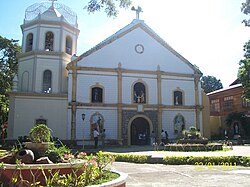San Juan, Ilocos Sur
| San Juan | ||
|---|---|---|
| Municipality | ||
 |
||
|
||
 Map of Ilocos Sur showing the location of San Juan |
||
| Location within the Philippines | ||
| Coordinates: 17°43′45″N 120°27′39″E / 17.7292°N 120.4608°ECoordinates: 17°43′45″N 120°27′39″E / 17.7292°N 120.4608°E | ||
| Country | Philippines | |
| Region | Ilocos (Region I) | |
| Province | Ilocos Sur | |
| District | 1st District | |
| Barangays | 32 | |
| Government | ||
| • Mayor | Benjamin Viloria Sarmiento | |
| Area | ||
| • Total | 64.37 km2 (24.85 sq mi) | |
| Population (2015 census) | ||
| • Total | 26,411 | |
| • Density | 410/km2 (1,100/sq mi) | |
| Time zone | PST (UTC+8) | |
| ZIP code | 2731 | |
| IDD : area code | +63 (0)77 | |
| Income class | 3rd class | |
San Juan (formerly Lapog) is a third class municipality in the province of Ilocos Sur, Philippines. According to the 2015 census, it has a population of 26,411 people.
Because it produces most of the goods made of buri leaf in the province, it is sometimes called the Buri Capital of Ilocos Sur.
The town of Lapog was established in 1772.
The name of the municipality has gone through a series of changes. The early settlers and occupants called it "Lapo", short for "Lapo-Lapo", a tall grass which grew everywhere in the area. In the year 1772, Don Tomas Aquino, the first local leader, initiated the organization of the scattered communities into one, calling the place "Lapog", a derivative of local vernacular "Lap-Lapog" which means unirrigated land. For 189 years, "Lapog" remained in the records as the official name of the town until June 18, 1961, Republic Act No. 3386 was enacted and it was renamed to San Juan. Since most of the inhabitants were of the belief that religious names bring peace, happiness, and prosperity, the town was renamed "San Juan", after the name of its patron saint, Saint John the Baptist.
It was stricken by all sorts of plagues and epidemics (like the smallpox epidemics of 1808 and 1918–19, locust infestation in 1903, and destruction of ricefields by worms called "arabas" in 1905). Bessang Pass, just south of the poblacion, was constructed in 1874. Americans destroyed their town hall in 1903. But despite these misfortunes, San Juan progressed into a prosperous community.
San Juan is politically subdivided into 32 barangays.
In the 2015 census, the population of San Juan, Ilocos Sur, was 26,411 people, with a density of 410 inhabitants per square kilometre or 1,100 inhabitants per square mile.
...
Wikipedia


